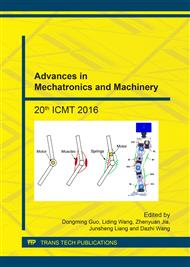p.3
p.9
p.15
p.21
p.27
p.33
p.39
p.45
p.51
A Research and Design of Intelligent Detecting and Controlling System for Automatic Assembly Force
Abstract:
In this paper, we designed a set of multipurpose intelligent detecting and controlling system for automatic assembly force. To actualize detecting, analyzing and controlling hole-peg assembly force. Firstly, we founded the assembly model, and simulated and analyzed the main factors which make great effect on axial force. We briefly introduced the assembly mechanism, compliant wrist and paw, the functions and operational principles of this system. This system has three detecting modes, users can select one from the three in “mode selection”, and they can also set the parameters. We also designed the hardware and the software. We tested and simulated all the modules for many times to improve their reliability and facticity. At last, we illustrated the anti-jamming measures we took in the design. After all the tests, this system could work well.
Info:
Periodical:
Pages:
27-32
Citation:
Online since:
July 2017
Authors:
Keywords:
Price:
Сopyright:
© 2017 Trans Tech Publications Ltd. All Rights Reserved
Share:
Citation:


